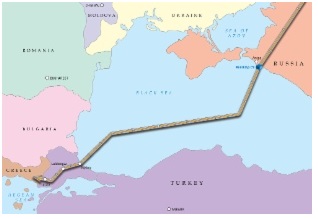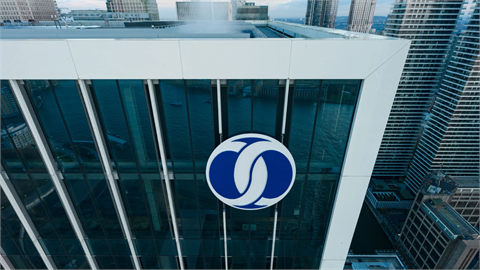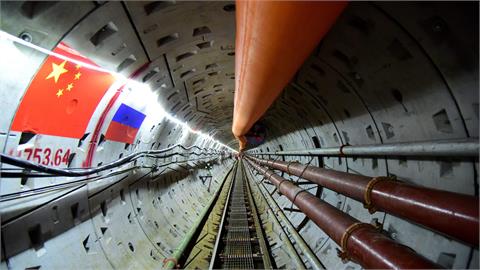by John M. Roberts* In the second half of 2017, the world’s most modern pipe-laying barge will lay the first string of the Turkish Stream pipeline across the Black Sea from Russia to Turkey
In the second half of 2017, the world’s most modern pipe-laying barge will lay the first string of the Turkish Stream pipeline across the Black Sea from Russia to Turkey.
Despite all the vicissitudes of recent Russian-Turkish relations, including the assassination of the Russian ambassador to Turkey Andrei Karlov December 19, the two nations remain committed to laying at least one 15.75bn m³/yr pipe between Russia’s offloading terminal near Anapa and a landing site at Kiyikoy, on the Black Sea coast of Turkish Thrace.
But there is still a lot that remains uncertain. These mainly concern the question of a second string – in effect another 15.75bn m³/yr pipeline running roughly parallel to the first; the question of a connection to the Turkish-Greek border; the issue of who would be served by a second string; and the possibility of foreign partnership in the offshore component of the new system.
This much is known: on December 8, a wholly-owned subsidiary of Gazprom, the Russian gas giant that is developing the project, signed a contract in Amsterdam with the Swiss-registered Allseas group to lay more than 900 km of line on the floor of the Black Sea.
In a reminder of Turkish Stream’s role as heir to previous Gazprom efforts to use the Black Sea as southern supply route to the European Union, the contract was actually signed by a Gazprom subsidiary, South Stream Transport, a Dutch-registered company originally set up to develop the long-planned South Stream pipeline from Anapa to Bulgaria and then on to the Austrian hub at Baumgarten.
Allseas will use the state-of-the art Pioneering Spirit, with its six on-board welding stations and six on-board coating stations, to lay the line. In Gazprom’s announcements concerning the contract there was, however, no mention of one curious fact: as far back as April 2014, Allseas had secured a previous contract from South Stream Transport to lay South Stream’s second string, using the same vessel. At that time, however, the ship was called the Pieter Schelte, in honour of Pieter Schelte Heerema, the father of Allseas founder, owner and president Edward Heerema. The name was changed to the Pioneering Spirit in the wake of protests concerning Pieter Heerema’s role as a Dutch officer in Nazi Germany’s notorious Waffen SS during World War Two.
Gazprom has not said how much either of the Allseas’ contracts were worth. But since South Stream Transport originally agreed to pay Italy’s Saipem €2bn ($2.1bn) for the original contract to lay the first string of South Stream and some ancillary works, the assumption was that Allseas’ 2014 contract was worth around €1.2-1.5bn.
Although both South Stream and Turkish Streamwere originally conceived as four-string systems capable of handling 63bn m³/yr, at present Gazprom seems to be focused on getting just the first string operational, with the possibility of adding a second. In June 2016, referring to a four-string system, Gazprom’s deputy head of finance, Igor Shatalov, declared: "The Turkish Stream project has been meticulously worked out. The cost of the four lines was estimated at about at €11.4bn.” A two-string system would cost substantially less than this. Moreover, €1.8bn of physical pipe, ordered in early 2014 for the planned first two strings of South Stream, has already been delivered and is stacked up on the dockside at the Bulgarian port of Varna.
The presence of this piping makes it highly likely that Gazprom will go ahead with a second string for Turkish Stream, even though the intergovernmental agreement (IGA) signed by the Turkish and Russian ministers of energy in Istanbul October 10 gives Russia the right to cancel the second line.
The uncertainties concerning the second line do not relate so much to the issue of whether it will be built as to the use that will be made of it. The IGA provides for Gazprom and/or its affiliates to have 100% ownership of the offshore section and for Turkey’s Botas to have 100% ownership of the onshore section; a logical arrangement since the agreement specifies that the onshore section shall terminate at a connection "with the existing gas system of the Republic of Turkey.” In practice, this means Botas will be sole owner and operator of a short line of around 80 km from Kiyikoy to Luleburgaz, the nearest potential junction with Turkey’s main distribution system.
However, while the second offshore line will be 100% Gazprom and/or its affiliates, the onshore line to "to the border of the Republic of Turkey with its neighbouring countries” will be a 50-50 partnership between Gazprom and Botas. In practice, this is expected to follow the onshore section to Luleburgaz and then run 130 km further to Ipsala, on the Turkey-Greece border. The significance of Ipsala (on the Turkish side of the border, and of Kipoi on the Greek side) is that this is the point at which the Tanap pipeline across Turkey connects to the Trans-Adriatic Pipeline (TAP) across Greece and Albania in order to deliver Azerbaijani gas to Europe.
So far, Gazprom has provided no indication that it might be interested in shipping gas carried by Turkish Stream’s second string to European customers via TAP, although EU rules specifically allow for third party access to the second 10bn m³/yr element of TAP capacity.
Indeed, judging by a meeting held in Moscow on 13 December between Gazprom, Italy’s Edison and Depa, Greece’s gas supplier, Gazprom is still looking at options to deliver second string Turkish Streamgas to Europe via a wholly new pipeline system intended to reach Italy by means of a new pipeline across Greece and the revival of an old project – Poseidon – for a direct 200-km pipeline across the Adriatic from Greece to Italy. At the very least, the talks with Edison indicate that Italy and France – since Edison is owned by Electricite de France – are very much in Gazprom’s sights when it comes to identifying potential European Union customers for Russian gas deliveries via Turkish Stream.
The problem is who will finance such an approach. In June, Shatalov said with regard to the overall Turkish Streamproject that "the level of readiness to attract project financing is very high.” The IGA carefully leaves the way open for third parties to join the system, specifying that both the company developing the offshore section (in effect, Gazprom) and the company developing the onshore section to connect to the second string (in effect, the Gazprom-Botas consortium) "may raise third party funding.”
At present, there is no indication as to which third parties might be approached to help defray Turkish Stream’s cost.Meanwhile, the most salient fact remains the simplest. As Gazprom stated in its announcement December 8: "Allseas will start building the first string of the pipeline in the second half of 2017.”
picture: Route of Turkish Stream (Credit: Gazprom)
*John M. Roberts is a senior fellow at Atlantic Council's Dinu Patriciu Eurasia Center and Global Energy Center
(http://www.naturalgasworld.com, 29 December, 2016)




